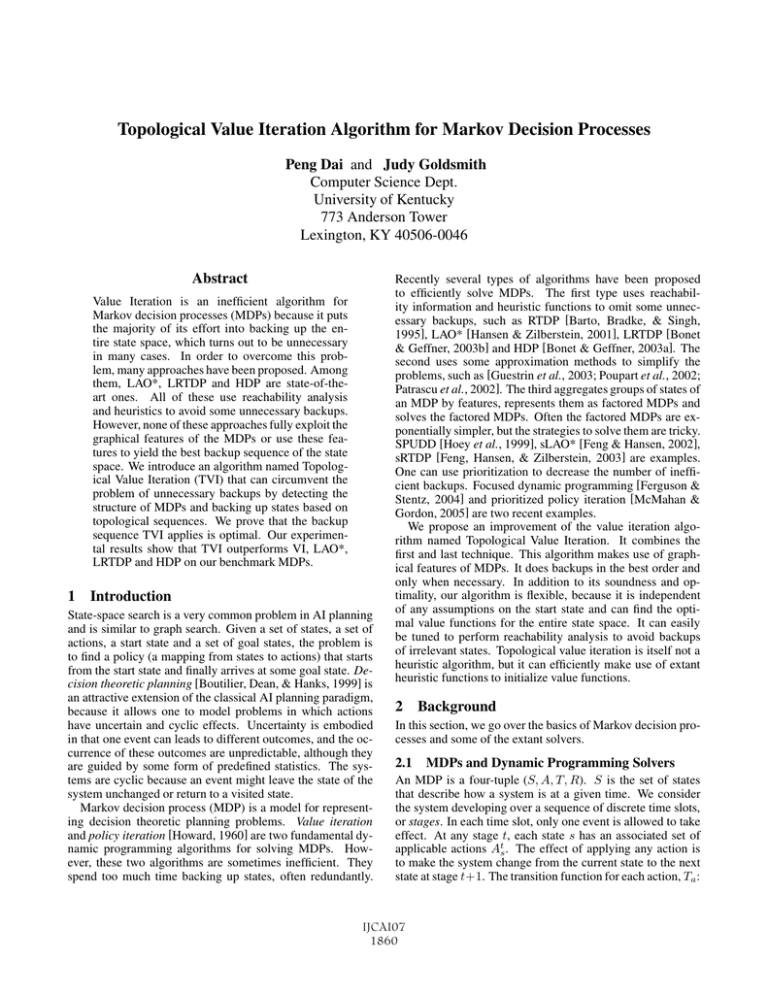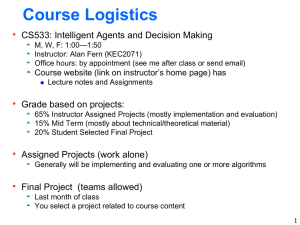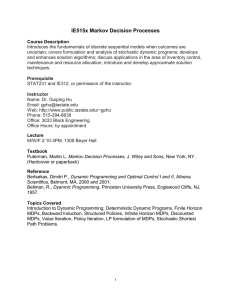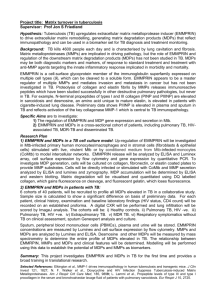Topological Value Iteration Algorithm for Markov Decision Processes
advertisement

Topological Value Iteration Algorithm for Markov Decision Processes
Peng Dai and Judy Goldsmith
Computer Science Dept.
University of Kentucky
773 Anderson Tower
Lexington, KY 40506-0046
Abstract
Value Iteration is an inefficient algorithm for
Markov decision processes (MDPs) because it puts
the majority of its effort into backing up the entire state space, which turns out to be unnecessary
in many cases. In order to overcome this problem, many approaches have been proposed. Among
them, LAO*, LRTDP and HDP are state-of-theart ones. All of these use reachability analysis
and heuristics to avoid some unnecessary backups.
However, none of these approaches fully exploit the
graphical features of the MDPs or use these features to yield the best backup sequence of the state
space. We introduce an algorithm named Topological Value Iteration (TVI) that can circumvent the
problem of unnecessary backups by detecting the
structure of MDPs and backing up states based on
topological sequences. We prove that the backup
sequence TVI applies is optimal. Our experimental results show that TVI outperforms VI, LAO*,
LRTDP and HDP on our benchmark MDPs.
1 Introduction
State-space search is a very common problem in AI planning
and is similar to graph search. Given a set of states, a set of
actions, a start state and a set of goal states, the problem is
to find a policy (a mapping from states to actions) that starts
from the start state and finally arrives at some goal state. Decision theoretic planning [Boutilier, Dean, & Hanks, 1999] is
an attractive extension of the classical AI planning paradigm,
because it allows one to model problems in which actions
have uncertain and cyclic effects. Uncertainty is embodied
in that one event can leads to different outcomes, and the occurrence of these outcomes are unpredictable, although they
are guided by some form of predefined statistics. The systems are cyclic because an event might leave the state of the
system unchanged or return to a visited state.
Markov decision process (MDP) is a model for representing decision theoretic planning problems. Value iteration
and policy iteration [Howard, 1960] are two fundamental dynamic programming algorithms for solving MDPs. However, these two algorithms are sometimes inefficient. They
spend too much time backing up states, often redundantly.
Recently several types of algorithms have been proposed
to efficiently solve MDPs. The first type uses reachability information and heuristic functions to omit some unnecessary backups, such as RTDP [Barto, Bradke, & Singh,
1995], LAO* [Hansen & Zilberstein, 2001], LRTDP [Bonet
& Geffner, 2003b] and HDP [Bonet & Geffner, 2003a]. The
second uses some approximation methods to simplify the
problems, such as [Guestrin et al., 2003; Poupart et al., 2002;
Patrascu et al., 2002]. The third aggregates groups of states of
an MDP by features, represents them as factored MDPs and
solves the factored MDPs. Often the factored MDPs are exponentially simpler, but the strategies to solve them are tricky.
SPUDD [Hoey et al., 1999], sLAO* [Feng & Hansen, 2002],
sRTDP [Feng, Hansen, & Zilberstein, 2003] are examples.
One can use prioritization to decrease the number of inefficient backups. Focused dynamic programming [Ferguson &
Stentz, 2004] and prioritized policy iteration [McMahan &
Gordon, 2005] are two recent examples.
We propose an improvement of the value iteration algorithm named Topological Value Iteration. It combines the
first and last technique. This algorithm makes use of graphical features of MDPs. It does backups in the best order and
only when necessary. In addition to its soundness and optimality, our algorithm is flexible, because it is independent
of any assumptions on the start state and can find the optimal value functions for the entire state space. It can easily
be tuned to perform reachability analysis to avoid backups
of irrelevant states. Topological value iteration is itself not a
heuristic algorithm, but it can efficiently make use of extant
heuristic functions to initialize value functions.
2 Background
In this section, we go over the basics of Markov decision processes and some of the extant solvers.
2.1
MDPs and Dynamic Programming Solvers
An MDP is a four-tuple (S, A, T, R). S is the set of states
that describe how a system is at a given time. We consider
the system developing over a sequence of discrete time slots,
or stages. In each time slot, only one event is allowed to take
effect. At any stage t, each state s has an associated set of
applicable actions Ats . The effect of applying any action is
to make the system change from the current state to the next
state at stage t+1. The transition function for each action, Ta :
IJCAI07
1860
S × S → [0, 1], specifies the probability of changing to state
s after applying a in state s. R : S → R is the instant reward
(in our formulation, we use C C, the instant cost, instead of
R). A value function V , V : S → R, gives the maximum
value of the total expected reward from being in a state s.
The horizon of a MDP is the total number of stages the system evolves. In problems where the horizon is a finite number
H
H, our aim is to minimize the value V (s) = i=0 C(si ) in
H steps. For infinite-horizon problems, the reward is accumulated over an infinitely long path. To define the values of
an infinite-horizon problem, we introduce a discount factor
γ ∈ [0, 1] for each accumulated
reward. In this case, our goal
i
γ
C(si ).
is to minimize V (s) = ∞
i=0
Given an MDP, we define a policy π : S → A to be a
mapping from states to actions. An optimal policy tells how
we choose actions at different states in order to maximize the
expected reward. Bellman [Bellman, 1957] showed that the
expected value of a policy π can be computed using the set
of value functions V π . For finite-horizon MDPs, V0π (s) is
π
according to Vtπ :
defined to be C(s), and we define Vt+1
π
(s) = C(s) +
{Tπ(s) (s |s)Vtπ (s )}.
(1)
Vt+1
s ∈S
For infinite-horizon MDPs, the (optimal) value function is defined as:
Ta (s |s)V (s )], γ ∈ [0, 1].
V (s) = mina∈A(s) [C(s) + γ
s ∈S
(2)
The above two equations are named Bellman equations.
Based on Bellman equations, we can use dynamic programming techniques to compute the exact value of value functions. An optimal policy is easily extracted by choosing an
action for each state that contributes its value function.
Value iteration is a dynamic programming algorithm that
solves MDPs. Its basic idea is to iteratively update the value
functions of every state until they converge. In each iteration,
the value function is updated according to Equation 2. We
call one such update a Bellman backup. The Bellman residual of a state s is defined to be the difference between the
value functions of s in two consecutive iterations. The Bellman error is defined to be the maximum Bellman residual of
the state space. When this Bellman error is less than some
threshold value, we conclude that the value functions have
converged sufficiently. Policy iteration [Howard, 1960] is another approach to solve infinite-horizon MDPs, consisting of
two interleaved steps: policy evaluation and policy improvement. The algorithm stops when in some policy improvement
phase, no changes are made. Both algorithms suffer from efficiency problems. Although each iteration of each algorithm
is bound polynomially in the number of states, the number of
iterations is not [Puterman, 1994].
The main drawback of the two algorithm is that, in each iteration, the value functions of every state are updated, which
is highly unnecessary. Firstly, some states are backed up before their successor states, and often this type of backup is
fruitless. We will show an example in Section 3. Secondly,
different states converge with different rates. When only a
few states are not converged, we may only need to back up a
subset of the state space in the next iteration.
2.2
Other solvers
Barto et al. [Barto, Bradke, & Singh, 1995] proposed an
online MDP solver named real time dynamic programming.
This algorithm assumes that initially the algorithm knows
nothing about the system except the information on the start
state and the goal states. It simulates the evolution of the
system by a number of trials. Each trial starts from the start
state and ends at a goal state. In each step of the trial, one
greedy action is selected based on the current knowledge and
the state is changed stochastically. During the trial, all the
visited states are backed up once. The algorithm succeeds
when a certain number of trials are finished.
LAO* [Hansen & Zilberstein, 2001] is another solver that
uses heuristic functions. Its basic idea is to expand an explicit graph G iteratively based on some type of best-first
strategy. Heuristic functions are used to guide which state is
expanded next. Every time a new state is expanded, all its ancestor states are backed up iteratively, using value iteration.
LAO* is a heuristic algorithm which uses the mean first passage heuristic. LAO* converges faster than RTDP since it
expands states instead of actions.
The advantage of RTDP is that it can find a good suboptimal policy pretty fast, but the convergence for RTDP is
slow. Bonet and Geffner extended RTDP to labeled RTDP
(LRTDP) [Bonet & Geffner, 2003b], and the convergence of
LRTDP is much faster. In their approach, they mark a state
s as solved if the Bellman residuals of s and all the states
that are reachable through the optimal policy from s are small
enough. Once a state is solved, we regard its value function as
converged, so it is treated as a “tip state” in the graph. LRTDP
converges when the start state is solved.
HDP is another state-of-the-art algorithm, by Bonet and
Geffner [Bonet & Geffner, 2003a]. HDP not only uses a
similar labeling technique to LRTDP, but also discovers the
connected components in the solution graph of a MDP. HDP
labels a component as solved when all the states in that component have been labeled. HDP expands and updates states
in a depth-first fashion rooted at the start states. All the
states belonging to the solved components are regarded as tip
states. Their experiments show that HDP dominated LAO*
and LRTDP on most of the racetrack MDP benchmarks when
the heuristic function hmin [Bonet & Geffner, 2003b] is used.
The above algorithms all make use of start state information by constraining the number of backups. The states that
are unreachable from the start state are never backed up. They
also make use of heuristic functions to guide the search to the
promising branches.
3 A limitation of current solvers
None the algorithms listed above make use of inherent features of MDPs. They do not study the sequence of state backups according to an MDP’s graphical structure, which is the
intrinsic property of an MDP and potentially decides the complexity of solving it [Littman, Dean, & Kaelbling, 1995]. For
example, Figure 1 shows a simplified version of an MDP. For
simplicity, we omit explicit action nodes, transition probabilities, and reward functions. The goal state is marked in the
figure. A directed edge between two states means the second
IJCAI07
1861
state is a potential successor state when applying some action
in the first state.
s1
s2
s3
s4
Goal
Figure 1: A simplified MDP
Observing the MDP in Figure 1, we know the best sequence to back up states is s4 , s3 , s2 , s1 , and if we apply
this sequence, all the states except s1 and s2 only require
one backup. However, not enough efforts of the algorithms
mentioned above have been put to detect this optimal backup
sequence. At the moment when they start on this MDP, all
of them look at solving it as a common graph search problem
with 5 vertices and apply essentially the same strategies as
solving an MDP whose graphical structure is equivalent to a
5-clique, although this MDP is much simpler to solve than a
5-clique MDP. So the basic strategies of those solvers do not
have an “intelligent” subroutine to distinguish various MDPs
and to use different strategies to solve them. With this intuition, we want to design an algorithm that is able to discover
the intrinsic complexity of various MDPs by studying their
graphical structure and to use different backup strategies for
MDPs with different graphical properties.
4 Topological Value Iteration
Our first observation is that states and their value functions
are causally related. If in an MDP M , one state s is a successor state of s after applying action a, then V (s) is dependent
on V (s ). For this reason, we want to back up s ahead of s.
The causal relation is transitive. However, MDPs are cyclic
and causal relations are very common among states. How
do we find an optimal backup sequence for states? Our idea
is the following: We group states that are mutually causally
related together and make them a metastate, and let these
metastates form a new MDP M . Then M is no longer
cyclic. In this case, we can back up states in M in their reverse topological order. In other words, we can back up these
big states in only one virtual iteration. How do we back up
the big states that are originally sets of states? We can apply
any strategy, such as value iteration, policy iteration, linear
programming, and so on. How do we find those mutually
causally related states?
To answer the above question, let us look at the graphical
structure of an MDP first. An MDP M can be regarded as
a directed graph G(V, E). The set V has state nodes, where
each node represents a state in the system, and action nodes,
where each action in the MDP is mapped to a vertex in G.
The edges, E, in G represent transitions, so they indicate the
causal relations in M . If there is an edge e from state node
s to node a, this means a is a candidate action for state s.
Conversely, an edge e pointing from a to s means, applying
action a, the system has a positive probability of changing to
state s . If we can find a path s → a → s in G, we know
that state s is causally dependent on s . So if we simplify
G by removing all the action nodes, and changing paths like
s → a → s into directed edges from s to s , we get a causal
relation graph Gcr of the original MDP M . A path from state
s1 to s2 in Gcr means s1 is causally dependent on s2 . So the
problem of finding mutually causally related groups of states
is reduced to the problem of finding the strongly connected
components in Gcr .
We use Kosaraju’s [Cormen et al., 2001] algorithm of detecting the topological order of strongly connected components in a directed graph. Note that Bonet and Geffner [Bonet
& Geffner, 2003a] used Tarjan’s algorithm in detection of
strongly connected components in a directed graph in their
solver, but they do not use the topological order of these
components to systematically back up each component of an
MDP. Kosaraju’s algorithm is simple to implement and its
time complexity is only linear in the number of states, so
when the state space is large, the overhead in ordering the
state backup sequence is acceptable. Our experimental results also demonstrate that the overhead is well compensated
by the computational gain.
The pseudocode of TVI is shown in Figure 2. We first
use Kosaraju’s algorithm to find the set of strongly connected
components C in graph Gcr , and their topological order. Note
that each c ∈ C maps to a set of states in M . We then use
value iteration to solve each c. Since there are no cycles in
those components, we only need to solve them once. Notice
that, when the entire state space is causally related, TVI is
equivalent to VI.
Theorem 1 Topological Value Iteration is guaranteed to
converge to the optimal value function.
Proof We first prove TVI is guaranteed to terminate in finite
time. Since each MDP contains a finite number of states, it
contains a finite number of connected components. In solving
each of these components, TVI uses value iteration. Because
value iteration is guaranteed to converge in finite time, TVI,
which is actually a finite number of value iterations, terminates in finite time. We then prove TVI is guaranteed to converge to the optimal value function. According to the update
sequence of TVI, at any point of the algorithm, the value functions of the states (of one component) that are being backed
up only depend on the value functions of the components that
have been backed up, but not on those of the components that
have not been backed up. For this reason, TVI lets the value
functions of the state space converge sequentially. When a
component is converged, the value functions of the states can
be safely used as tip states, since they can never be influenced
by components backed up later.
A straightforward corollary to the above theorem is:
Corollary 2 Topological Value Iteration only updates the
value functions of a component when it is necessary. And
the update sequence of the update is optimal.
4.1
Optimization
In our implementation, we added two optimizations to our algorithm. One is reachability analysis. TVI does not assume
any initial state information. However, given that information, TVI is able to detect the unreachable components and
IJCAI07
1862
Topological Value Iteration
TVI(MDP M , δ)
1 . scc(M )
2 . for i ← 1 to cpntnum;
3 . S ← the set of states s where s.id = cpntnum
4 . vi(S, δ)
vi(S: a set of states, δ)
5 . while (true)
6 . for each state s ∈ S
7 . V (s) = mina∈A(s) [C(s) + γ s ∈S Ta (s |s)V (s )]
8 . if (Bellman error is less than δ)
9 . return
scc(MDP M ) (Kosaraju’s algorithm)
10. construct Gcr from M by removing action nodes
11. construct the reverse graph Gcr of Gcr
12. size ← number of states in Gcr
13. for s ← 1 to size
14. s.id ← −1
15. // postR and postI are two arrays of length size
16. cnt ← 1, cpntnum ← 1
17. for s ← 1 to size
18. if (s.id = −1)
19. df s(G , s)
20. for s ← 1 to size
21. postR[s] ← postI[s]
22. cnt ← 1, cpntnum ← 1
23. for s ← 1 to size
24. s.id ← −1
25. for s ← 1 to size
26. if (s.id = −1)
27. df s(Gcr , postR[s])
28. cpntnum ← cpntnum + 1
29. return (cpntnum, Gcr )
dfs(Graph G, s)
30. s.id ← cpntnum
31. for each successor s of s
32. if (s .id = −1)
33. df s(G, s )
34. postI[cnt] ← s
35. cnt ← cnt + 1
Figure 2: Pseudocode of Topological Value Iteration
ignore them in the dynamic programming step. Reachability
is computed by a depth first search. The overhead of this analysis is linear, and it helps us avoid considering the unreachable components, so the gains can well compensate for the
trouble introduced. It is extremely useful when only a small
portion of the state space is reachable. Since the reachability analysis is straightforward, we do not provide any pseudocode for it. The other optimization is the use of heuristic
functions. Heuristic values can serve as a good starting point
for value functions in TVI. In our program, we use the hmin
heuristic from [Bonet & Geffner, 2003b]. Reachability analysis and the use of heuristics help strengthen the competitiveness of TVI. hmin replaces the expected future reward part of
the Bellman equation by the minimum of such value. It is an
admissible heuristic.
hmin (s) = mina [C(s) + γ · mins :Ta (s |s)>0 V (s )]. (3)
5 Experiment
We tested the topological value iteration and compared its
running time against value iteration (VI), LAO*, LRTDP and
HDP. All the algorithms are coded in C and properly optimized, and run on the same Intel Pentium 4 1.50GHz processor with 1G main memory and a cache size of 256kB. The
operating system is Linux version 2.6.15 and the compiler is
gcc version 3.3.4.
5.1
Domains
We use two MDP domains for our experiments. The first
domain is a model simulating PhD qualifying exams. We
consider the following scenario from a fictional department:
To be qualified for a PhD in Computer Science, one has to
pass exams in each CS area. Every two months, the department offers exams in each area. Each student takes each
exam as often as he wants until he passes it. Each time,
he can take at most two exams. We consider two types of
grading criteria. For the first criterion, we only have pass
and fail (and of course, untaken) for each exam. Students
who have not taken and who have failed certain exam before have the same chance of passing that exam. The second criterion is a little trickier. We assign pass, conditional
pass, and fail to each exam, and the probabilities of passing
certain exams vary, depending on the student’s past grade on
that exam. A state in this domain is a value assignment of the
grades of all the exams. For example, if there are five exams,
fail,pass,pass,condpass,untaken is one state. We refer to the
first criterion MDPs as QEs (e) and second as QEt (e), where
e refers to the number of exams.
For the second domain, we use artificially-generated “layered” MDPs. For each MDP, we define the number of states,
and partition them evenly into a number nl of layers. We
number these layers by numerical values. We allow states in
higher numbered layers to be the successor states of states in
lower numbered layers, but not vice versa, so each state has
only a limited set of allowable successor states succ(s). The
other parameters of these MDPs are: the maximum number
of actions each state can have is ma , the maximum number of
successor states of each action, ms . Given a state s, we let the
pseudorandom number generator of C pick the number of actions from [1, ma ], and for each action, we let that action have
a number of successor states in [1, ms ]. The states are chosen
uniformly from succ(s) together with normalized transition
probabilities. The advantage of generating MDPs this way is
that these layered MDPs contain at least nl connected components.
There are actual applications that lead to multi-layered
MDPs. A simple example is the game Bejeweled: each level
is at least one layer. Or consider a chess variant without
pawns, played against a stochastic opponent. Each set of
pieces that could appear on the board together leads to (at
least one strongly-connected component. There are other,
more serious examples, but we know of no multi-layered
standard MDP benchmarks. Examples such as race-track
MDPs tend to have a single scc, rendering TVI no better than
VI. (Since checking the topological structure of an MDP takes
negligible time compared to running any of the solvers, it is
IJCAI07
1863
domain
|S|
|a|
#of scc s
v ∗ (s0 )
hmin
VI(h = 0)
LAO*(h = 0)
LRTDP(h = 0)
HDP(h = 0)
TVI(h = 0)
VI(hmin )
LAO*(hmin )
LRTDP(hmin )
HDP(hmin )
TVI(hmin )
QEs (7)
2187
28
2187
11.129919
4.0
1.08
0.73
0.44
5.44
0.42
1.05
0.53
0.28
4.42
0.16
QEs (8)
6561
36
6561
12.640260
4.0
4.28
4.83
1.91
75.13
1.36
4.38
3.75
1.22
59.71
0.56
QEs (9)
19683
45
19683
14.098950
5.0
15.82
26.72
7.73
1095.11
4.50
15.76
19.16
4.90
768.59
1.86
QEs (10)
59049
55
59049
15.596161
5.0
61.42
189.15
32.65
1648.11
15.89
61.06
126.84
20.15
1583.77
6.49
QEt (5)
1024
15
243
7.626064
3.0
0.31
0.27
0.28
0.75
0.20
0.31
0.25
0.28
0.95
0.19
QEt (6)
4096
21
729
9.094187
4.0
1.89
2.18
2.05
29.37
1.04
1.87
1.94
1.95
30.14
0.98
QEt (7)
16384
28
2187
10.565908
4.0
10.44
16.57
16.68
1654.00
5.49
10.41
14.96
16.22
1842.62
5.29
QEt (8)
65536
36
6561
12.036075
5.0
59.76
181.44
126.75
2130.87
35.10
59.73
123.26
124.69
2915.05
30.79
Table 1: Problem statistics and convergence time in CPU seconds for different algorithms with different heuristics for the qual.
exams examples ( = 10−6 )
easy to decide whether to use TVI.) Thus, we use our artificially generated MDPs for now.
5.2
Results
We consider several variants of our first domain, and the results are shown in Table 1. The statistics have shown that:
• TVI outperforms the rest of the algorithms in all the instances. Generally, this fast convergence is due to both
the appropriate update sequence of the state space and
avoidance of unnecessary updates.
• The hmin helps TVI more than it helps VI, LAO* and
LRTDP, especially in the QEs domains.
• TVI outperforms HDP, because our way of dealing with
components is different. HDP updates states of all the
unsolved components together in a depth-first fashion
until they all converge. We pick the optimal sequence of
backing up components, and only back up one of them
at a time. Our algorithm does not spend time checking
whether all the components are solved, and we only update a component when it is necessary.
We notice that HDP shows pretty slow convergence in the QE
domain. That is not due to our implementation. HDP is not
suitable for solving problems with large numbers of actions.
Readers interested in the performance of HDP on MDPs with
smaller action sets can refer to [Bonet & Geffner, 2003a].
The statistics of the performance on artificially generated
layered MDPs are shown in Table 2 and 3. We do not include
the HDP statistics here, since HDP is too slow in these cases.
We also ignore the results on applying the hmin heuristic,
since they display the same scale as not using the heuristic.
For each element of the table, we take the average of running
20 instances of MDPs with the same configuration. Note that
varying |S|, nl , ma , and ms yields many MDP configurations. We present a few whose results are representative.
For the first group of data, we fix the state space to have
size 20,000 and change the number of layers. Statistics in Table 2 show our TVI dominates others. We note that, as the
layer number increases, the MDPs become more complex,
since the states in large numbered layers have relatively small
succ(s) against ms , therefore cycles in those layers are more
common, so it takes greater effort to solve large numbered
layers than small numbered ones. Not surprisingly, from Table 2 we see that when the number of layers increases, the
running time of each algorithm also increases. However, the
increase rate of TVI is the smallest (the rate of greatest against
smallest running time of TVI is 2 versus 4 of VI, 3.5 of LAO*,
and 2.3 of LRTDP). This is due to the fact that TVI applies the
best update sequence. As the layer number becomes large, although the update of the large numbered layers requires more
effort, the time TVI spends on the small numbered ones remains stable. But other algorithms do not have this property.
For the second experiment, we fix the number of layers and
vary the state space size. Again, TVI is better than other algorithms, as seen in Table 3. When the state space is 80,000,
TVI can solve the problems in around 12 seconds. This shows
that TVI can solve large problems in a reasonable amount of
time. Note that the statistics we include here represent the
common cases, but were not chosen in favor of TVI. Our best
result shows, TVI runs in around 9 seconds for MDPs with
|S|=20,000, nl =200, ma =20, ms =40, while VI needs more
than 100 seconds, LAO* takes 61 seconds and LRTDP requires 64 seconds.
6 Conclusion
We have introduced and analyzed an MDP solver, topological value iteration, that studies the dependence relation of
the value functions of the state space and use the dependence
relation to decide the sequence to back up states. The algorithm is based on the idea that different MDPs have different
graphical structures, and the graphical structure of an MDP
intrinsically determines the complexity of solving that MDP.
We notice that no current solvers detect this information and
use it to guide state backups. Thus, they solve MDPs of the
same problem sizes but with different graphical structure with
IJCAI07
1864
nl
VI(h = 0)
LAO*(h = 0)
LRTDP(h = 0)
TVI(h = 0)
20
19.482
6.088
9.588
2.563
40
17.787
6.584
9.651
2.686
60
12.310
5.702
8.483
2.587
80
24.538
7.297
8.352
2.624
100
31.684
9.250
11.165
2.805
200
40.782
12.801
11.108
3.186
300
46.554
12.463
13.125
3.061
400
52.248
12.259
13.443
4.065
500
64.706
16.255
14.160
4.264
600
77.658
21.991
22.057
5.131
Table 2: Problem statistics and convergence time in CPU seconds for different algorithms on solving layered MDPs with
different number of layers (|s|=20000, ma =10, ms =20, = 10−6 )
|S|
VI(h = 0)
LAO*(h = 0)
LRTDP(h = 0)
TVI(h = 0)
10000
9.322
3.056
3.903
1.212
20000
27.683
6.201
8.814
2.589
30000
38.529
10.561
10.725
4.055
40000
46.178
13.663
20.708
5.571
50000
64.915
21.409
27.156
7.133
60000
72.087
23.461
53.773
8.626
70000
95.479
29.248
49.954
10.307
80000
117.359
38.746
50.730
11.969
Table 3: Problem statistics and convergence time in CPU seconds for different algorithms on solving layered MDPs with
different state spaces (nl =20, ma =10, ms =20, = 10−6 )
almost the same strategies. In this sense, they are not “intelligent”. Topological value iteration is proposed to solve this
problem. It is guaranteed to find the optimal solution of a
Markov decision process sequentially. Topological value iteration is a flexible algorithm, which can use the initial state
information and apply reachability analysis. However, even
without this information, TVI runs soundly and completely.
We coded up an academic example and our experimental results show that TVI outperforms not only VI, but also
LAO*, LRTDP and HDP, state of the art algorithms. The reason is because our algorithm is able to detect the optimal sequence of updating each component and components are only
updated when necessary. Without standard, layered benchmarks, we test our algorithm on artificially generated layered
MDPs. Our results on these MDPs have shown that TVI is
extremely useful in MDPs with many connected components.
The complexity increase of TVI is not as great as other algorithms as the number of layers increase, which shows that
TVI is very suitable for solving MDPs with layered structures.
References
[Barto, Bradke, & Singh, 1995] Barto, A.; Bradke, S.; and Singh,
S. 1995. Learning to act using real-time dynamic programming.
JAI 72:81–138.
[Bellman, 1957] Bellman, R. 1957. Dynamic Programming.
Princeton, NJ: Princeton University Press.
[Bonet & Geffner, 2003a] Bonet, B., and Geffner, H. 2003a. Faster
heuristic search algorithms for planning with uncertainty and full
feedback. In Gottlob, G., ed., Proc. of IJCAI-03, 1233–1238.
Acapulco, Mexico: Morgan Kaufmann.
[Bonet & Geffner, 2003b] Bonet, B., and Geffner, H. 2003b. Labeled RTDP: Improving the convergence of real-time dynamic
programming. In Giunchiglia, E.; Muscettola, N.; and Nau, D.,
eds., Proc. 13th ICAPS, 12–21. Trento, Italy: AAAI Press.
[Boutilier, Dean, & Hanks, 1999] Boutilier, C.; Dean, T.; and
Hanks, S. 1999. Decision-theoretic planning: Structural assumptions and computational leverage. JAIR 11:1–94.
[Cormen et al., 2001] T. H. Cormen, C. E. Leiserson, R. L. Rivest,
and C. Stein. Introduction to Algorithms, Second Edition. The
MIT Press, 2001.
[Feng & Hansen, 2002] Feng, Z., and Hansen, E. A. 2002. Symbolic heuristic search for factored Markov decision processes. In
Proc. of AAAI-05.
[Feng, Hansen, & Zilberstein, 2003] Feng, Z.; Hansen, E. A.; and
Zilberstein, S. 2003. Symbolic generalization for on-line planning. In Proc. of UAI-03, 209–216.
[Ferguson & Stentz, 2004] Ferguson, D., and Stentz, A. 2004. Focussed dynamic programming: Extensive comparative results.
Technical Report CMU-RI-TR-04-13, Carnegie Mellon University, Pittsburgh, PA.
[Guestrin et al., 2003] Guestrin, C.; Koller, D.; Parr, R.; and
Venkataraman, S. 2003. Efficient solution algorithms for factored MDPs. JAIR 19:399–468.
[Hansen & Zilberstein, 2001] Hansen, E., and Zilberstein, S. 2001.
LAO*: A heuristic search algorithm that finds solutions with
loops. JAI 129:35–62.
[Hoey et al., 1999] Hoey, J.; St-Aubin, R.; Hu, A.; and Boutilier, C.
1999. SPUDD: Stochastic planning using decision diagrams. In
Proc. of UAI-99, 279–288.
[Howard, 1960] Howard, R. 1960. Dynamic Programming and
Markov Processes. Cambridge, Massachusetts: MIT Press.
[Littman, Dean, & Kaelbling, 1995] Littman, M. L.; Dean, T.; and
Kaelbling, L. P. 1995. On the complexity of solving Markov
decision problems. In Proc. of UAI-95, 394–402.
[McMahan & Gordon, 2005] McMahan, H. B., and Gordon, G. J.
2005. Fast exact planning in Markov decision processes. In Proc.
of ICAPS-05.
[Patrascu et al., 2002] Patrascu, R.; Poupart, P.; Schuurmans, D.;
Boutilier, C.; and Guestrin, C. 2002. Greedy linear valueapproximation for factored Markov decision processes. In Proc.
of AAAI-02, 285–291.
[Poupart et al., 2002] Poupart, P.; Boutilier, C.; Patrascu, R.; and
Schuurmans, D. 2002. Piecewise linear value function approximation for factored MDPs. In Proc. of AAAI-02, 292–299.
[Puterman, 1994] Puterman, M. 1994. Markov Decision Processes:
Discrete Stochastic Dynamic Programming. John Wiley, New
York.
IJCAI07
1865







